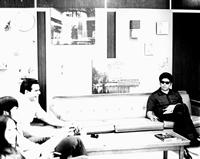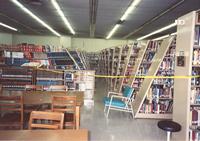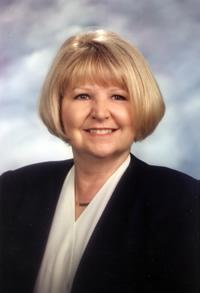1967-2002
The Jensen Presidency, 1967-1986
Arthur M. Jensen came to Valley College in July 1967 from a position with the Bureau of Junior College Education in the California State Department of Education. The first half of Jensen's presidency saw the completion of the building program on the Valley College campus. The Medical Arts building was completed in 1969. The following year, the Liberal Arts Building, housing offices for the English and Social Science faculties, and containing a small auditorium, several seminar-sized classrooms and the Learning Center, was completed. The old gymnasium was considered beyond rehabilitation, and a new facility, the Joseph Snyder Gymnasium, replaced it in 1975. An Art Gallery, dedicated in 1976, and a Planetarium, completed in 1977 on the site of the original gymnasium, were the last buildings constructed on the campus.
The new construction permitted the razing or removal of the last of the houses purchased at the time of the campus expansion. Buildings that had been used as classrooms or offices for Nursing, English, Police Science and Geography were now abandoned. The completion of the new Art Gallery permitted the razing of the "Little Gallery."
Enrollment at the college grew steadily year after year until it reached a total of approximately 18,000 day and evening students in 1975. Since that time, enrollment has decreased, due to the expiration of veterans' benefits, the opening and growth of Crafton Hills College, and other factors.
Changes in curriculum mirrored the changing social and economic conditions. The civil rights movement resulted in a substantial increase in the number of minority students. Occupational courses were in great demand, and courses in psychology and philosophy also became increasingly popular.
Student attitudes toward other phases of traditional college life also underwent a transition. Attendance at assemblies and convocations declined noticeably. Activities such as homecoming also suffered, both because of lack of student interest in football and because there was a growing feeling that such events had no "relevance." Dress codes, which had previously been accepted by students and faculty alike, were all but forgotten.
Racial and political confrontation came to the campus early in the Jensen administration. A story in the college newspaper that was critical of a presentation made by an off-campus speaker at a "Black Culture Day" program led to a demand by the Black Student Union that the paper's faculty adviser and student author be dismissed. Another confrontation occurred when four students locked themselves in the staff lounge of the Campus Center, a pressure tactic that eventually led to the establishment of a Chicano Cultural Center on the campus. Student concern was also expressed by demonstrations in opposition to the Vietnam War. During the period of greatest activism, a "free speech area" with a permanent podium was established at the southeast corner of the Quad, in front of the Campus Center.

Dr. Jensen's last years were trying ones because of the reductions and retrenchments made necessary by changing financial conditions. As early as 1975, concerns were expressed about insufficient funding resulting from the imposition of a state apportionment "cap" which threatened for force one of three options: limiting enrollment, requiring a local tax increase, or cutting program offerings. While a new school finance bill removed this threat in 1976, a more serious problem emerged in 1978 with the statewide Jarvis Initiative (Proposition 13). Both the Board of Trustees and the Valley College Academic Senate passed resolutions opposing the measure, but such opposition had little effect on the outcome, and the measure passed easily.
The results of the passage of Proposition 13 were immediate. The 1978 summer session was cancelled. Class offerings in the fall of 1978 were reduced by ten percent. Faculty and staff vacancies were largely left unfilled, hourly help was drastically reduced, and many part-time faculty were released. Budgets for travel were decreased, and a virtual freeze was placed on the purchase of new or replacement equipment.
The introduction of state-mandated tuition in 1984 also had an impact on the college. For the first time in many years, the student enrollment dropped below ten thousand. The decreasing enrollment in turn meant less revenue from the state, since state funds were allotted on the basis of enrollment. Financial considerations also brought about the transfer or elimination of some occupational programs to prevent duplication of effort between Valley College and Crafton Hills College.
Dr. Jensen retired at the end of the 1985-1986 academic year. He had served as president for nineteen years, longer than any of his predecessors.
The Rivera Presidency, 1986-1990
Dr. Manuel Rivera was chosen as Valley College's eighth president. Prior to his appointment, Rivera had served as the Vice President for Academic Affairs at San Antonio College in Texas.
The combination of decreased enrollment and limited funding led the Board of Trustees to encourage the retirement of older tenured faculty by offering a severance bonus. In the spring of 1987, it was announced that a fifteen percent cut in the Valley College faculty might be necessary, but as a result of retirement incentives, thirty-two faculty members accepted the "golden handshake."
Elwood Price, a much-loved employee and grounds supervisor who had given more than thirty years service to Valley College, died on the night of the 1987 graduation ceremonies. A small part area north of the Life Science Building has been dedicated to his memory.
The Richardson Astronomical Observatory, which had suffered from lack of its intended use for many years - having served as a storage room and then as headquarters for the campus police - was restored to its original use. An official re-opening of the facility took place in the spring of 1990.
The Singer Presidency, 1990-1997
Dr. Rivera's contract was not renewed by the Board of Trustees, and he stepped down from the presidency when his contract expired in the spring of 1990. Dr. Donald Singer, President of Crafton Hills College, was named interim president for the 1990-1991 academic year, and was later appointed to the permanent position.
The Singer years were filled with a variety of challenges for the institution. Faced with increasing enrollments and a cap on state funding, the college faculty and administration held a forum in 1991 to discuss "Whom Shall We Serve?" Initiatives to bring new populations to the campus were reduced, while state mandated tuition was increased, resulting in a sharp drop in enrollment. An earthquake in 1992 severely damaged the book stacks on the main floor of the Library, causing the facility to be closed down for the summer while they were being repaired. The college came to the attention of the media when it became the focus of two lawsuits. One complaint, lodged in 1992, charged an English professor with creating a hostile environment because of the nature of his assignments and the language he used in class. The U.S. Ninth Circuit Court of Appeals later ruled in the professors favor, resulting in a landmark sexual harassment decision. In 1995, another student filed a suit because she was not allowed to enroll in an English class designed to provide supplemental support for minority students.


During the winter break for the 1995-96 academic year, trenching began to determine the vulnerability of the campus to future seismic activity. The results of the study revealed that seven of the fifteen buildings on campus straddled or were near the San Jacinto earthquake fault, and would eventually have to be taken down.
A high point of the Singer years was a visit to the campus by President Bill Clinton in February 1995. President Clinton spoke to a standing-room-only crowd in the Snyder Gym, and also met with a select group of students, faculty and administration to discuss educational issues of the day. A second celebrity visitor graced the campus in 1996, when Hillary Clinton visited the campus and spoke in the Auditorium.
The Caballero Presidency, 1997-2002
Don Singer retired in 1997, and Sharon Caballero was appointed as his replacement in July of that same year. Prior to coming to San Bernardino Valley College, Dr. Caballero was the Vice President of Instruction at Rio Hondo College. A proponent of professional development, she had also been actively involved in the creation of statewide training programs for women administrators and for mid-managers.
The need to identify a funding source to build new facilities to replace the seven buildings that straddled the fault line presented an immediate challenge for President Caballero. Through a combination of district and college efforts, contacts with FEMA and the positive outcome of a state higher education bond resulted in a commitment of over $40 million to erect replacement structures. Steven Ehrlich, a noted architect, was hired to design the new Administration, Science, Campus Center, Library and Art buildings.
Among Dr. Caballero's other accomplishments was the invigoration of the campus arts and lectures series. Campus speakers included Angela Davis and the Tuskegee Airmen, as well as a series of regularly scheduled theatrical performances and concerts. The campus hosted its first annual "Bookfest" in 1999, a celebration of books and authors that was designed to attract all members of the community. About 1,500 community members attended the second Bookfest. Noted author Sidney Sheldon was a featured guest. He participated in a question-and-answer session and signed books.

Valley College’s 75th anniversary was marked in 2001 with celebrations on campus and with the community. The SBVC Foundation and Alumni Association held a gala for 500 guests, including faculty, staff, board members, business and education leaders, and members of Congress. A memory book honoring 75 people and businesses of distinction and recognizing the 1926-2001 SBVC Alumni Hall of Fame inductees was published to commemorate the event. Campus history was preserved in "A Vision in the Valley: SBVC’s First 75 Years and Beyond," by Gary Kellum, funded by San Bernardino Valley College Student Activities and published by The Arrowhead.
In the aftermath of September 11, the entire campus community came together in vigils, meetings, and discussions. Counseling was offered to all affected by the tragedy.
In Fall 2002, many offices were moved and centralized—referred to as “musical chairs”—in preparation for the first phase of the the 10-phase plan for construction, reconstruction, and demolition to make the campus earthquake-safe. Construction was officially kicked off in May 2002 with the Library groundbreaking ceremony.
While the campus was being rebuilt physically, it continued to grow technologically. The Library began offering online subscription databases: EBSCO MasterFile, with over 1,800 full-text titles, and SIRS Researching, with approximately 1,500 domestic and international newspapers, magazines, journals, and government publications. The Writing Center, after 3 years of serving students on campus, began offering online tutoring, as well. Campuswide, faculty received new computers, and a plan was put in place to replace computers in student labs every 2 years.
New educational programs were instituted to address student and community needs and interests. Inspired by the Route 66 Rendezvous, Valley started offering a certificate program in automobile restoration, the only one of its kind in the Western United States. Other programs were instituted to meet the growing and diverse needs of the Inland Empire economy: geographic information systems, pharmacy technology, paralegal, airline travel, automobile restoration, nonprofit accounting and more.
On campus, the Chemistry Department started the MESA (Math, Engineering, Science, Achievement) program to recruit students to the study of science and support them with tutoring, workshops, peer support, and academic counseling. Reaching future students, the Extra Edge Program sent teams of professors, students, and community leaders to middle schools to speak to at-risk students about staying in school and attending college.
Valley College and the San Bernardino City Unified School District opened the Middle College High School Program. This program allows high-potential high school students to attend high school and college classes simultaneously, and many students graduate with their high school diplomas and associate degrees.
Caballero initiated KinderCaminata: college outreach to kindergartners from the surrounding school districts. Over the years, nearly 5,000 kindergartners visited campus, meeting professors and exploring classrooms, the Library, and learning labs. This successful—and fun—program encouraged young students to consider future careers and college studies.
The Caballero presidency also saw a change in the college’s mascot. After false starts and some controversy, the college adopted the Wolverine and introduced the new mascot with a gala ceremony with the San Manuel Band of Mission Indians.

